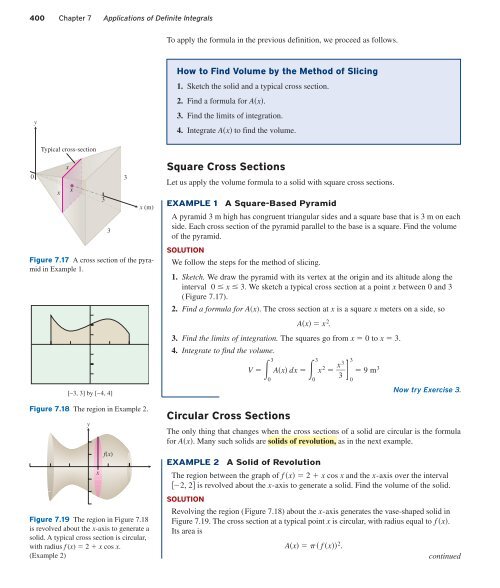Create successful ePaper yourself
Turn your PDF publications into a flip-book with our unique Google optimized e-Paper software.
400 Chapter 7 Applications of Definite Integrals<br />
To apply the formula in the previous definition, we proceed as follows.<br />
y<br />
How to Find Volume by the Method of Slicing<br />
1. Sketch the solid and a typical cross section.<br />
2. Find a formula for Ax.<br />
3. Find the limits of integration.<br />
4. Integrate Ax to find the volume.<br />
Typical cross-section<br />
0<br />
x<br />
x<br />
x<br />
x (m)<br />
Figure 7.17 A cross section of the pyramid<br />
in Example 1.<br />
3<br />
3<br />
3<br />
Square Cross Sections<br />
Let us apply the volume formula to a solid with square cross sections.<br />
EXAMPLE 1<br />
A Square-Based Pyramid<br />
A pyramid 3 m high has congruent triangular sides and a square base that is 3 m on each<br />
side. Each cross section of the pyramid parallel to the base is a square. Find the volume<br />
of the pyramid.<br />
SOLUTION<br />
We follow the steps for the method of slicing.<br />
1. Sketch. We draw the pyramid with its vertex at the origin and its altitude along the<br />
interval 0 x 3. We sketch a typical cross section at a point x between 0 and 3<br />
(Figure 7.17).<br />
2. Find a formula for Ax. The cross section at x is a square x meters on a side, so<br />
Ax x 2 .<br />
3. Find the limits of integration. The squares go from x 0 to x 3.<br />
4. Integrate to find the volume.<br />
V 3<br />
Ax dx 3<br />
x 2 x 3<br />
3<br />
3<br />
] 9m 3<br />
0<br />
0<br />
0<br />
Now try Exercise 3.<br />
[–3, 3] by [–4, 4]<br />
Figure 7.18 The region in Example 2.<br />
y<br />
f(x)<br />
Figure 7.19 The region in Figure 7.18<br />
is revolved about the x-axis to generate a<br />
solid. A typical cross section is circular,<br />
with radius f (x) 2 x cos x.<br />
(Example 2)<br />
x<br />
Circular Cross Sections<br />
The only thing that changes when the cross sections of a solid are circular is the formula<br />
for Ax. Many such solids are solids of revolution, as in the next example.<br />
EXAMPLE 2<br />
A Solid of Revolution<br />
The region between the graph of f x 2 x cos x and the x-axis over the interval<br />
2, 2 is revolved about the x-axis to generate a solid. Find the volume of the solid.<br />
SOLUTION<br />
Revolving the region (Figure 7.18) about the x-axis generates the vase-shaped solid in<br />
Figure 7.19. The cross section at a typical point x is circular, with radius equal to f x.<br />
Its area is<br />
Ax p f x 2 .<br />
continued












